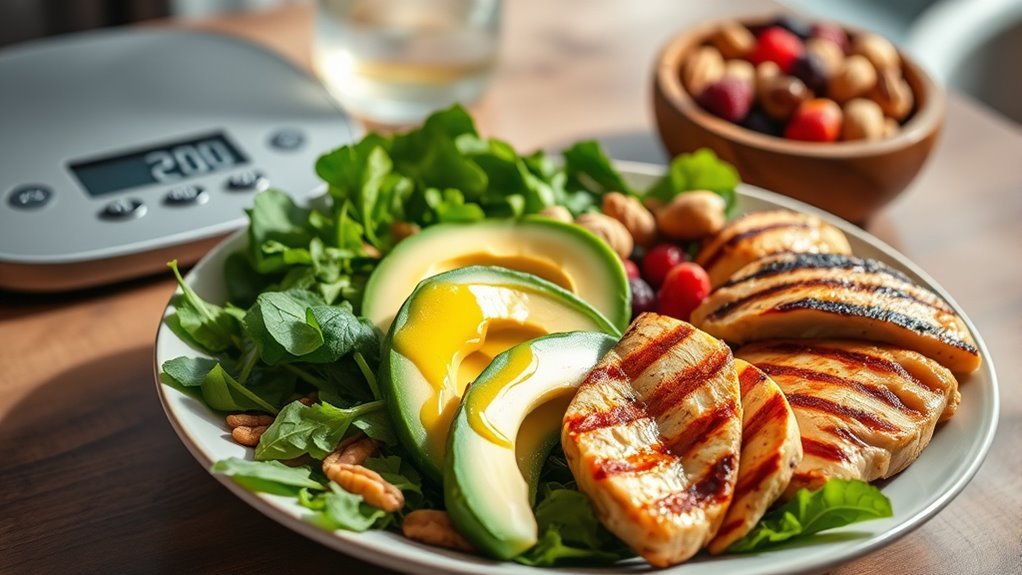To maintain ketosis, you should restrict your daily carb intake to about 20 to 50 grams. This helps shift your body’s energy source from glucose to fat. Prioritize high-quality carbs like non-starchy vegetables and avoid sugary snacks or processed foods. Individual metabolism and lifestyle factors can affect your specific needs, so pay attention to how your body responds. There’s more to explore about carb quality and tracking methods for a successful keto journey.
Understanding Ketosis and Carbohydrate Intake

When you’re aiming for ketosis, understanding the balance of carbohydrate intake is crucial. Ketosis basics revolve around greatly reducing carbs to shift your body from glucose to fat for energy. Your carb metabolism changes as you limit sugars and starches, prompting your liver to produce ketones. This metabolic state can enhance fat burning, but it requires careful management of carb consumption.
Most people need to restrict their daily carb intake to about 20 to 50 grams, depending on individual factors like activity level and metabolic health. By monitoring your carbs, you can achieve and maintain ketosis, enjoying the freedom to explore various low-carb foods while fueling your body efficiently. Embracing this shift empowers you to reclaim your health and energy.
Recommended Daily Carb Limits for Keto

When following a ketogenic diet, most people aim for a daily carb limit of around 20 to 50 grams to maintain ketosis. However, it’s important to recognize that individual factors, such as activity level and metabolic health, can influence your specific carbohydrate needs. Understanding these variations can help you tailor your carb intake for ideal results.
Standard Carb Limit
The standard carb limit for a ketogenic diet typically ranges from 20 to 50 grams of net carbohydrates per day. Many keto misconceptions suggest that all carbs are equal, but it’s essential to focus on the quality of your carb sources. Non-starchy vegetables, nuts, and seeds are great choices, while sugary snacks and processed foods should be avoided. By sticking to this carb limit, you can encourage your body to enter ketosis, where it burns fat for fuel instead of carbs. Remember, everyone’s body is different, so finding your personal balance is key. Embracing this freedom in your choices can lead to a sustainable and enjoyable keto lifestyle. Stay informed and make smart carb decisions!
Individual Variation Factors
While aiming for a ketogenic diet, it’s crucial to recognize that recommended daily carb limits can vary greatly among individuals. Your individual metabolism plays a significant role in determining how many carbs you can consume while still remaining in ketosis. Factors such as age, activity level, and overall health can influence your carb tolerance. Additionally, genetic factors can affect your body’s ability to metabolize carbohydrates, leading to different responses to the same diet. Some may thrive on a strict 20 grams of carbs daily, while others might find success with 50 grams or more. Understanding these variations allows you the freedom to tailor your approach, ensuring it aligns with your unique body and lifestyle.
Factors Affecting Individual Carb Needs

Understanding the factors that affect your individual carb needs is essential for successfully maneuvering a ketogenic diet. Your personal lifestyle plays a vital role; how active you are, your daily routines, and your overall health can greatly influence your carbohydrate intake. Additionally, metabolic health is a key aspect to take into account. Individuals with different metabolic rates may require varying amounts of carbs to maintain ketosis. Age, gender, and even hormonal balance can further alter your needs. It’s important to listen to your body and adjust accordingly, ensuring you stay within a range that supports your goals. Finding that sweet spot will empower you to enjoy the benefits of a ketogenic lifestyle while maintaining your freedom in food choices.
Types of Carbohydrates: What to Avoid
Identifying the types of carbohydrates to avoid can greatly impact your ability to maintain ketosis. To maximize your success, steer clear of these:
- Simple sugars: Found in sweets and sugary drinks, these can spike insulin levels and disrupt ketosis.
- Processed foods: Often packed with hidden carbs and unhealthy additives, they compromise carbohydrate quality.
- Starchy vegetables: Foods like potatoes and corn can be high in carbs; opting for low carb alternatives is a better choice.
While whole grains and some fiber sources can be healthy in moderation, they may still contain carbs that hinder your goals. Focus on understanding carbohydrate quality to make informed choices and enhance your freedom on the keto journey.
Tracking Your Carb Intake Effectively
Tracking your carb intake is essential for staying within your keto goals. You can start with the basics of carb counting, utilize various tools for tracking, and implement effective meal planning strategies to make the process easier. Understanding these elements will help you maintain control over your carbohydrate consumption and support your overall health.
Carb Counting Basics
When you begin a keto diet, mastering carb counting becomes essential for staying within your daily limits and achieving your health goals. Here are three key principles to keep in mind for effective carb counting:
- Know Your Limits: Aim for 20-50 grams of net carbs per day to maintain ketosis.
- Track All Carbs: Don’t just count carbs from main meals; include snacks and beverages too.
- Balance Your Macros: Focus on a ratio of fats, proteins, and carbs that works for you, typically around 70% fats, 25% proteins, and 5% carbs.
Tools for Tracking
Mastering carb counting is just the beginning; having the right tools can make the process much easier and more accurate. Tracking apps are incredibly useful in helping you monitor your daily carb intake effortlessly. Many of these apps provide extensive food databases, barcode scanning, and even meal suggestions tailored to your preferences. Alternatively, food diaries offer a more hands-on approach, allowing you to jot down everything you eat throughout the day. This method can deepen your awareness of your eating habits. Whichever tool you choose, consistency is key. By regularly tracking your carb intake, you’ll gain a better understanding of how different foods affect your body, empowering you to make informed choices while enjoying the freedom of a keto lifestyle.
Meal Planning Strategies
To effectively manage your carb intake on a keto diet, meal planning strategies play an essential role. Here are three useful tips to help you stay on track:
- Meal Prep: Preparing meals in advance not only saves time but also helps you control your carb intake. Batch-cook keto-friendly recipes to guarantee you have options ready to go.
- Portion Control: Be mindful of your serving sizes. Using food scales or measuring cups can help you accurately track your carb intake and avoid overeating.
- Plan Snacks: Keep low-carb snacks on hand to prevent impulse eating. This way, you’ll have satisfying options that align with your keto goals.
Tips for Staying Within Your Carb Limit
Although sticking to a low-carb diet can be challenging, there are effective strategies to help you stay within your carb limit. First, plan your snack options carefully; go for nuts, cheese, or veggie sticks instead of high-carb snacks. When dining out, choose grilled or roasted dishes, and don’t hesitate to ask for modifications to lower carb counts. Familiarize yourself with low-carb alternatives on menus, which can give you more flexibility. Using apps to track your carbs can also keep you accountable. Finally, keep your meals balanced by incorporating healthy fats and proteins, making it easier to feel full and satisfied without exceeding your limits. With these strategies, you can enjoy your meals while staying true to your low-carb goals.
Adjusting Your Carb Intake Over Time
As you progress on your keto journey, it’s essential to recognize that your carb intake might need adjustments over time. Here are three key considerations for adjusting gradually:
- Monitor Progress: Keep track of your weight, energy levels, and overall well-being. These indicators can signal when it’s time to tweak your carb intake.
- Adapt to Activity Levels: If you increase physical activity, you might need to slightly raise your carbs to fuel your workouts without compromising ketosis.
- Listen to Your Body: Pay attention to how you feel. If you’re experiencing fatigue or cravings, it might be a sign to adjust your intake.


